#quikscript
Explore tagged Tumblr posts
Text
Learning an alternate form of English that was clearly intended to be used for British English is proving somewhat taxing
"On" is apparently supposed to be "ɒn," but I hear it as "ɔn" (more of an "awe" sound)
The example word for ɒ is "ox," but in American English that uses "a"!
Not? a!
Every word that seems like it's supposed to use the ɒ sound, it seems more appropriate to use a or ɔ, and I'm starting to think it might not even actually exist in American English
Does anyone know a single American word that actually uses ɒ???
2 notes
·
View notes
Text
Shaw himself for years wrote his literary works in Pitman shorthand. However, he found its limitations frustrating as well and realized that it was not a suitable replacement for traditional orthography, making the production of printed material difficult and impossible to type. Shaw desired and advocated a phonetic spelling reform, and this called for a new alphabet.[3]
All of his interest in spelling and alphabet reform was made clear in Shaw's will of June 1950, in which provision was made for (Isaac) James Pitman, with a grant in aid from the Public Trustee, to establish a Shaw Alphabet. Following Shaw's death in November 1950, and after some legal dispute, the Trustee announced a worldwide competition to design such an alphabet, with the aim of producing a system that would be an economical way of writing and of printing the English language. A contest for the design of the new alphabet was won by four people, including Ronald Kingsley Read who had corresponded extensively with Shaw for several years regarding such an alphabet. Read was then appointed to amalgamate the four designs to produce the new alphabet.[4]
Due to the contestation of Shaw's will, the trust charged with developing the new alphabet could afford to publish only one book: a version of Shaw's play Androcles and the Lion, in a bi-alphabetic edition with both conventional and Shavian spellings. (1962 Penguin Books, London). Copies were sent to major libraries in English-speaking countries.
Trabajo
See also
Quikscript
Readspel
Shorthand
Pitman shorthand
Gregg shorthand
Deseret alphabet
Unifon alphabet
English-language spelling reform
2 notes
·
View notes
Text
I certainly won't discourage you from learning a Polynesian language, but I recommend checking out Quikscript. It doesn't make distinctions based on length as far as I remember and it's not as fast as true shorthands, but once you're experienced with it you can definitely write faster than with the traditional Latin alphabet.
i really wish i could write shorthand, but i don't know if i wish it enough to actually learn a shorthand system
66 notes
·
View notes
Note
Hey Reid!! Another diary donation question for you. Hypothetically, would diaries written in shorthand be of interest one day? I write in Quikscript because it's faster, phonetic, and harder for people to read without permission - I've had issues with an old roommate reading them behind my back and I've been paranoid ever since. I've always assumed any diaries I keep would be considered useless down the line, but now I'm kinda curious to know if they'd still be useful one day. I'm gonna ask whoever I donate my mother's diaries to, but I'm interested to know what you and other history bloggers think.
Your diaries are absolutely still important and of interest! Chances are, someone will be able to research how to read Quikscript if they don't know it already.
OR your diaries will become foundational Quikscript texts, representing the most some of the complete documents in that shorthand. Someone 400 years down the line might do their dissertation on the decoding of your diaries... wouldn't that be super cool?!?!
-Reid
26 notes
·
View notes
Text
I’ve recently discovered quikscript and dscript I feel unstoppable now
1 note
·
View note
Text
Writing systems
Alternative scripts and notation systems
In this post, I explained the different writing systems in the world, including alphabets, syllabaries, and semanto-phonetic scripts, but there are alternative scripts and notation systems.
Alternative spelling systems
These writing and spelling systems are alternative ways of writing English and other languages. Most are designed to make it easier to learn how to write English.
Benjamin Franklin’s Phonetic Alphabet consists of all the lowercase letters of the Latin alphabet, minus c, j, q, w, and y (which Franklin considered redundant), plus six new letters for sounds which he believed lacked unambiguous orthographic representation (cɩ for /ɔː/ and /ɒ/, ɥ for /ʌ/, ի or ̊ի for /ʃ/, ŋ for /ŋ/, ⱨ for /θ/, ˇh̢ or ᷄h̢ for /ð/).
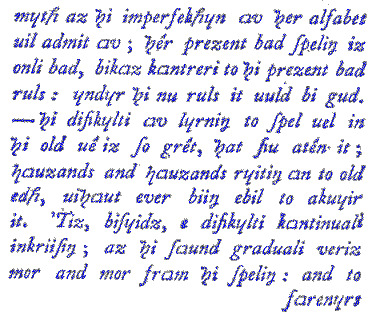
Much as the imperfections of the alphabet will admit of; the present bad spelling is only bad because contrary to the present bad rules: under the new rules it would be good—the difficulty of learning to spell well in the old way is so great, that few attain it; thousands and thousands writing on to old age, without ever being able to acquire it. ‘Tis, besides a difficulty continually increasing; as the sound gradually varies more and more from the spelling: and to foreigners.
The Deseret alphabet was devised as an alternative to the Latin alphabet and developed during the 1850s at the University of Deseret (now the University of Utah) by The Church of Jesus Christ of Latter-day Saints, also known as the Mormon. The name “Deseret” is taken from a word in the Book of Mormon and means “honeybee”. It reflects the Mormon use of the beehive as a symbol of co-operative industry.
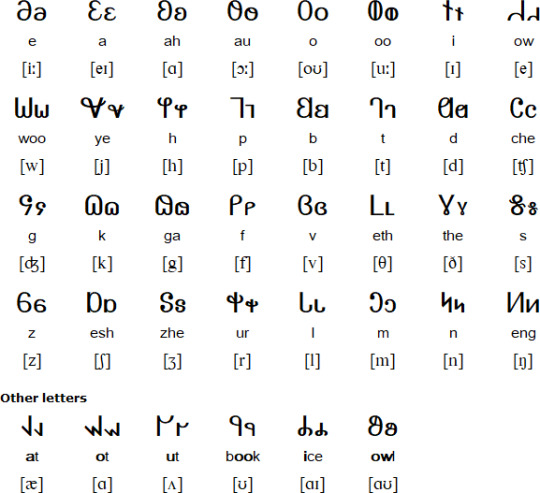
This is what the alphabet looks like.
Dialectal Paleotype was developed by Alexander J. Ellis to represent the dialects of English during the 1880s. The total number of symbols is over 250, some of them are the following:
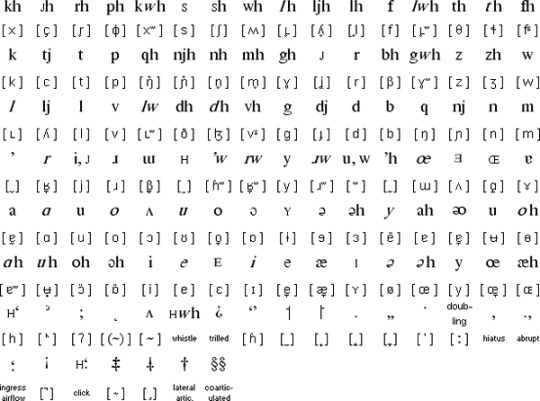

He was whining away, says she, for all the world like a sick child, or a little lass in a tizzy.
The Pitman Initial Teaching Alphabet (i.t.a) was invented by Sir James Pitman to make it easier for English-speaking children to learn to read English. However, since it is based on Received Pronunciation, people with other accents find it difficult to decipher and the transition to the traditional orthography can be difficult for children as well.
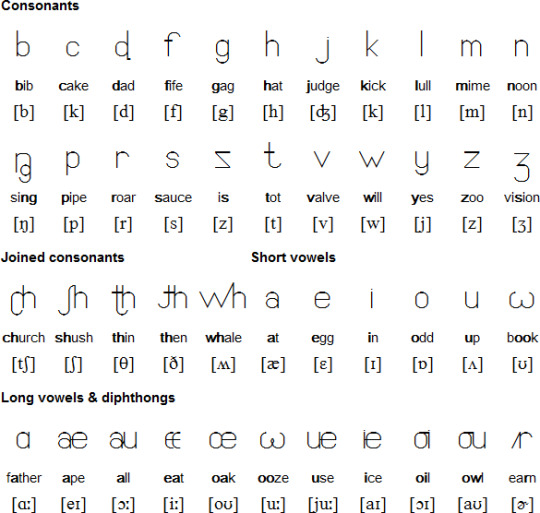
The alphabet consists of 42 letters, including 24 standard Latin letters.
Quikscript was created by Kingsley Read, who also created the Shavian alphabet, to improve various problems with the latter. There are two written forms: Junior and Senior. The letters in Junior Quickscript are mostly unconnected, with the exception of a few common dipthongs. Senior Quickscript is the semi-cursive “official” form of Quickscript: many letters have alternate forms which allow words to be handwritten with fewer lifts of the pen.
Junior Quikscript

Senior Quikscript

All human beings are born free and equal in dignity and rights. They are endowed with reason and conscience and should act towards one another in a spirit of brotherhood.
The Shavian or Shaw alphabet is named after George Bernard Shaw, who created a competition to create a new writing system for English, since the official one was according to him, a waste of time, energy and paper. There are three types of letters: tall, deep and short. Tall letters are the equivalent of ascenders in the Latin alphabet (e.g. b, d, f, h), deep letters are the equivalent of descenders (e.g. p, g, j, y), and short letters are all the same height, like the letters a, c, e and i. Consonant letters come in pairs, with the tall one representing an unvoiced consonant and the deep one representing a voiced consonant. There are no capital letters, although a ‘namer dot'’is used for proper names.
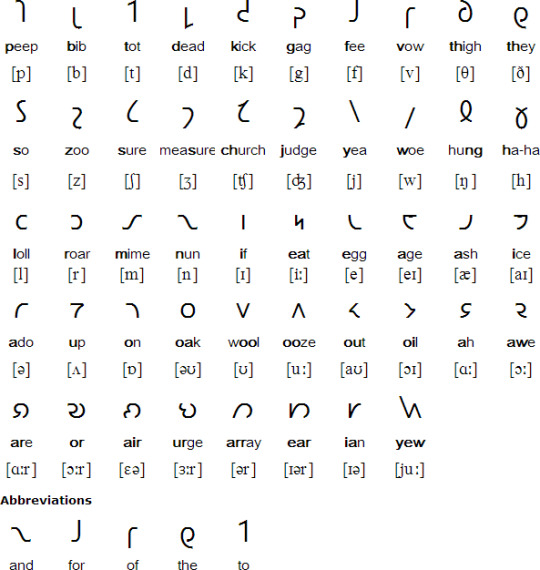
16 notes
·
View notes
Photo

Love this Noodlers Navajo Turquoise ink! #fountainpen #ink #quikscript #handwriting
0 notes
Text
I did a little more digging and I think I may have made a mistake in my pangram; though in IPA, "small" can be pronounced with either ɑ: (Ah) or ɔː (Aw), all Quikscript dictionaries that I've found specifically use Aw. For the sake of consistency between other Quikscript users, I have amended my pangram, and in doing so actually made it MORE efficient!
Ah, what j-oi she (the g-ay w-ih-ch) y-oo-zh-oo-uh-l-[ih] f-ow-n-d b-ai p-ue-t-ing h-eh-ks-z on eh-gz-ah-k-t-l-[ih] TH-r-ee s-m-awe-l v-o-l-z Ah, what joy she (the gay witch) usually found by putting hexes on exactly three small voles!

Now there are only 9 redundancies across 51 characters, as I was able to remove the Utter and No in "unusual", though I did end up moving the It from "in" to make "usually"
Sadly, I don't think it's as fun to not qualify the hexes as unusual, but it is better than saying "usual hexes." That would be objectively better for saving characters, at 50 w/ 8 redundancies, but it would sound awkward and be conceptually a little boring in my opinion, and I just won't stand for that
I also added in brackets so anyone using this for handwriting practice can get experience with the unique way they're written in Quikscript! If anyone has any suggestions for how I can further refine this or anything else I can add to it, like a way to incorporate Loch or Llan, I'm all ears!
0 notes
Text
Did a little research and found that not only is there already a term for a pangram that uses each grapheme only once (a "perfect pangram"), but even in orthodox English you can pretty much only get one by either using abbreviations (which I'm already doing) or loanwords, and even then you end up with something near unintelligible
So I decided to try relaxing my standards a bit and just going for a sentence that works and not sweat a couple of redundancies, though I still tried to keep them to a minimum
To that end, my pangram came out to be:
What j-oy she, the g-ay w-ih-ch, f-ow-n-d b-ai p-ue-t-ing uh-n-y-oo-zh-oo-uh-l h-eh-ks-z on eh-gz-ah-k-t-l-[ih] TH-r-ee s-m-ah-l v-oh-l-z in awe What joy she, the gay witch, found by putting unusual hexes on exactly three small voles in awe.

That gives me 53 characters total with 11 redundant graphemes
I imagine a more skilled linguist could have figured out a way to do it more succinctly, but I rather like what I came up with, and I feel pretty accomplished finally getting it done after several days of struggle
At some point I'll need to look into a font that lets me type in Senior Quikscript rather than Junior so that the letters will join and halve properly, but this is good enough for now
0 notes
Text
Pangram update
So far I've got
"What j-oy the w-i-ch f-ou-n-d p-u-t-ing k-ah-zh-u-uh-l h-eh-ks-z on b-ah-th-uh-r-s-uh-m..."
[Italics are words that are abbreviated to one letter, specifically the letters Why, They, and Ox; bolds are repeated letters]
I have Gay, Vie, She, Ye, Eat, Eight, I, Awe, Owe and Exam (gz) left to work with, but I don't know if I can make much more out of their constituent sounds without repeating anything else
I've already had to use Utter three times, I'm not too happy about that...
0 notes
Text
I've been trying desperately for the last several days to come up with a Quikscript pangram, and while I've certainly thought of enough words to do it a few times over, my goal is to do it with as few repeats as possible
The Platonic ideal would be exactly 44 characters (the 25 consonants, 15 vowels, two X's and the two Scottish/Welsh exclusives), but I have no idea if that's even possible, especially since I don't know any words that can use the Scottish/Welsh sounds
I've been going for the 42 I know I can use, though I could reasonably get away without the X's since they're special characters, and technically there's no reason to use WHy or Ox since those don't appear in American English anyway
If I really wanted to fudge it, I think doing it with the 38 I'd actually use consistently would be acceptable, but I'm trying to make something that would make a good tool for practicing penmanship for both myself and anyone else
I have found other pangrams online, but when I tried writing them out they didn't seem to have every letter, so I'm trying to make something a bit more comprehensive
0 notes
Text
Okay, so doing a little more digging, it sounds like there are literally no situations where I would use either ɒ or ʍ, so...should I just...not bother learning them? I feel like I should at least KNOW them, even if the sounds don't exist in English
I can't imagine I'll ever have the opportunity to use x or ɬ either since they're apparently incorporated into Quikscript to account for Welsh, though maybe I'd end up using the former if I ever needed to write Chanukah?
1 note
·
View note
Text
I decided to learn Quikscript over Shavian because it's supposedly better for dyslexia and handwriting, and while that seems to be true, Bay and Fee are literally the same character, just one is Deep and the other is Tall. I'm not sure if this was an unfortunate necessity for the sake of maintaining simplicity or just an oversight, but I'm a tad miffed
0 notes
Text
Just learned about Shavian, an alternate English phonemic alphabet, and immediately clocked that it's the same basic idea behind the language in Tunic
I don't know if the devs were inspired by it, but looking over the characters, I have to imagine that they were at least aware of it
#language#tunic#shavian#i'm so tempted to teach myself shavian or quikscript and then exclusively write in those when writing by hand#cus honestly i HATE writing in the latin alphabet. my handwriting has always been atrocious and i frankly don't care for english spelling
3 notes
·
View notes